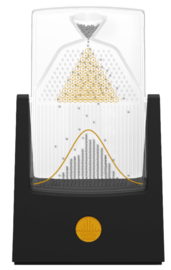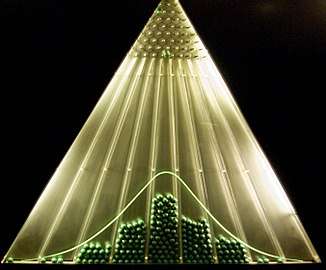Bean machine

The bean machine, also known as the Galton Board or quincunx, is a device invented by Sir Francis Galton[1]:63f to demonstrate the central limit theorem, in particular that the normal distribution is approximate to the binomial distribution. Among its applications, it afforded insight into regression to the mean or "regression to mediocrity".
Description
The Galton Board consists of a vertical board with interleaved rows of pegs. Beads are dropped from the top, and when the device is level, bounce either left or right as they hit the pegs. Eventually, they are collected into bins at the bottom, where the height of bead columns accumulated in the bins will eventually approximate a bell curve. Overlaying Pascal's triangle onto the pins shows the number of different paths that can be taken to get to each bin.[2]
Large-scale working models of this device created by Charles and Ray Eames can be seen in the Mathematica: A World of Numbers... and Beyond exhibits permanently on view at the Boston Museum of Science, the New York Hall of Science, or the Henry Ford Museum[3]. Another large-scale version is displayed in the lobby of Index Fund Advisors in Irvine, California.[4]
Distribution of the beads
If a bead bounces to the right k times on its way down (and to the left on the remaining pegs) it ends up in the kth bin counting from the left. Denoting the number of rows of pegs in a Galton Board by n, the number of paths to the kth bin on the bottom is given by the binomial coefficient . If the probability of bouncing right on a peg is p (which equals 0.5 on an unbiased level machine) the probability that the ball ends up in the kth bin equals . This is the probability mass function of a binomial distribution.
According to the central limit theorem (more specifically, the de Moivre–Laplace theorem), the binomial distribution approximates the normal distribution provided that both the number of rows and balls is large. Varying the rows will result in different standard deviations or widths of the bell-shaped curve or the normal distribution in the bins.
Examples
 Galton Board (7.5” by 4.5")
Galton Board (7.5” by 4.5").jpg) Before and after the spin
Before and after the spin A working replica of the machine (following a slightly modified design)
A working replica of the machine (following a slightly modified design)_-_Galton_1889_diagram.png) The bean machine, as drawn by Sir Francis Galton
The bean machine, as drawn by Sir Francis Galton
History
Sir Francis Galton was fascinated with the order of the bell curve that emerges from the apparent chaos of beads bouncing off of pegs in the Galton Board. He eloquently described this relationship in his book Natural Inheritance (1889):[1]:66
Order in Apparent Chaos: I know of scarcely anything so apt to impress the imagination as the wonderful form of cosmic order expressed by the Law of Frequency of Error. The law would have been personified by the Greeks and deified, if they had known of it. It reigns with serenity and in complete self-effacement amidst the wildest confusion. The huger the mob, and the greater the apparent anarchy, the more perfect is its sway. It is the supreme law of Unreason. Whenever a large sample of chaotic elements are taken in hand and marshalled in the order of their magnitude, an unsuspected and most beautiful form of regularity proves to have been latent all along.
Games
Several games have been developed utilizing the idea of pins changing the route of balls or other objects:
References
- 1 2 Galton, Sir Francis (1894). Natural Inheritance. Macmillan.
- ↑ "The Galton Board". www.galtonboard.com. Four Pines Publishing, Inc. Retrieved 2018-03-06.
- ↑ "Henry Ford museum acquires Eames' Mathematica exhibit". Auction Central News. LiveAuctioneers. 20 March 2015. Retrieved 2018-03-06.
- ↑ "IFA.tv - From Chaos to Order on the Galton Board -- A Random Walker". 23 December 2009. Retrieved 2018-03-06.
External links
| Wikimedia Commons has media related to Galton board. |
- Galton Board informational website with resource links
- A Bean Machine that simulates stock market returns
- A NetLogo simulation and explanation
- Plinko and the Binomial Distribution Interactive simulation
- An 8-foot-tall (2.4 m) Probability Machine (named Sir Francis) comparing stock market returns to the randomness of the beans dropping through the quincunx pattern. from Index Fund Advisors IFA.com
- A simulation with explanations
- Another simulation from John Carroll University
- Quincunx and its relationship to normal distribution from Math Is Fun
- Dynamical turbulent flow on the Galton board with friction
- Animations for the Bean Machine by Lijia Yu using Yihui Xie's R animation package animation
- Pascal's Marble Run: a deterministic Galton board
- Galton-i: board game with chance and tactics